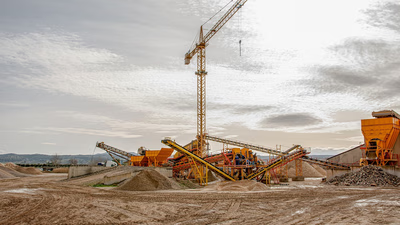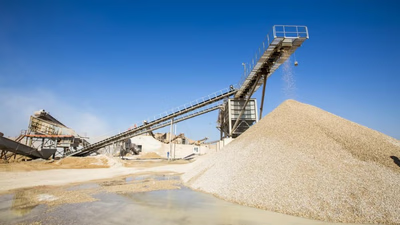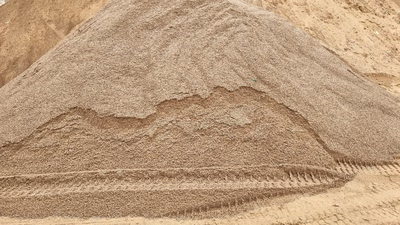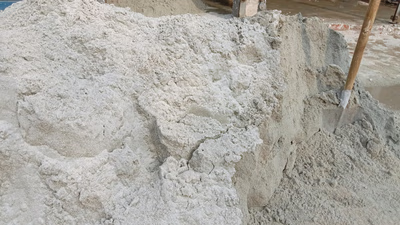
Different types of construction sands including river and beach sands.
River sand is naturally occurring sand found in riverbeds or banks. It is typically well-rounded and composed of fine to medium-sized grains. River sand is widely used in construction, particularly in concrete production, plastering, and masonry work. Beach sand is derived from coastal areas and is often a mix of minerals, including quartz, coral, shell fragments, and other organic materials. Beach sand is known for its fine particles and is commonly used in landscaping, sandboxes, and recreational areas. Pit sand is extracted from pits or quarries located on land. It is coarse-grained and often contains a mixture of various minerals. Pit sand is used in construction for applications like concrete works, filling trenches, and backfilling.
Natural sand is one of the coarse types of materials that are obtained from the depths of wells and are usually available in red and orange colors. In general, it can be stated that the appearance of these sands has a sharp and angular fracture and is used in concreting. River sands are obtained from rivers and have a much higher quality than sands obtained from pits. Their color is usually white to gray. Their appearance is completely round and without angles; Therefore, according to the mentioned features, this type of sand is used in plastering.
Fill sand, also known as utility sand or backfill sand, is typically used for filling voids, trenches, or low-lying areas. It is generally coarser in texture and may contain a mix of particles ranging from fine to coarse. In general, it can be acknowledged that synthetic sands are usually produced by crushing granite or basalt stones during three crushing stages and are a suitable alternative to river sands. These sands are produced in sand factories and by various stone crushers. Also, from another point of view, artificial sand can be examined in smaller sections, which includes this type of material
- Natural sand: Natural sand is extracted from the river bed, alluviums and cones and after being washed, it is used in a variety of ways. Their shape is round and polished.
- Broken sand: These sands are coarse and usually broken. Available in corner form.
- Washed sand: There are large amounts of soil and organic materials among the sands, which affect the efficiency of the sand, for this reason, it is washed and separates the sand from those materials.
- Light-grained sand: Sands such as pumice, tuff, clay, shale, diatomite and volcanic ash, which have low density, are called light-grained sand.
- Ordinary sand: The sand that exists around us naturally is called ordinary sand. This type of sand can be used to make concrete with normal weight.
- Heavy grain sand: grains such as serpentine, magnetite, ilmenite, geotite, limonite and barite are called heavy grain sands, which can be used to make heavy weight concrete.
- Natural sand: This type is naturally extracted from the sea and river bed.
- Washed sand: This type of sand is also called double salt, which is a mixture of sand and soil.
- Broken sand: this type has a sharp appearance and is obtained from the grinding of mineral stones.
- Round sand: As their name suggests, these sands have a round and spherical appearance. They are also artificial sand.
- Angled sand: This sand has high strength and the porosity between them is less than round sand.
- Semi-round sand: These grains do not have a completely round appearance, and some are round and some are angular.
- Mixed sand: this type of sand does not have a special shape.
Crushed stone sand, also known as M-Sand, is produced by crushing larger stones or rocks into smaller particles. M-Sand has angular grains and is free from organic and silt content. It is widely used in concrete production, plastering, and as a substitute for river sand in construction. Silica sand consists mainly of silicon dioxide (SiO2) and is characterized by its high silica content. It has a wide range of industrial applications, including glass manufacturing, foundry casting, ceramics, filtration systems, and hydraulic fracturing in the oil and gas industry. Desert sand refers to the sand found in arid regions like deserts. Unlike other types of sand, desert sand is not suitable for construction due to its rounded grains and lack of cohesion. The grains are often too smooth, making desert sand less stable for structural applications.
-

Sand is essential in construction, enhancing materials like concrete and mortar. Its physical properties improve cohesion, workability, and durability of building components. Sand fills voids between aggregates, reducing shrinkage and cracking risks. Different sand types allow for specific textures in plastering and rendering. It provides stability in structures, supports drainage systems, and is used in various applications such as glass production and metal casting molds. The quality of sand affects its efficiency; washed sand is preferred for better adhesion in cement mixtures. Sustainable sourcing practices are crucial to minimize environmental impacts. Sand"s versatility makes it a cost-effective choice for construction projects globally. "
-

Various types of sand serve distinct purposes in construction and industry. River sand, known for its well-rounded grains, is ideal for concrete and plastering. Beach sand, derived from coastal areas, is often used in landscaping due to its fine particles. Pit sand, extracted from quarries, is coarser and suitable for filling trenches. Natural sand, available in red and orange hues, is used in concreting due to its sharp fractures. Fill sand is utilized for voids and low-lying areas, while synthetic sands are produced from crushed stones as alternatives to river sands. Other types include washed sand, light-grained sand, ordinary sand, heavy grain sand, broken sand, round sand, angled sand, semi-round sand, and mixed sand. Crushed stone sand (M-Sand) is a popular substitute for river sand in construction due to its angular grains.
Silica sand has high industrial value with applications in glass manufacturing and hydraulic fracturing. Desert sand is unsuitable for construction because of its smooth grains that lack cohesion.
-

Sand extraction involves various methods tailored to the deposit"s location, including dredging in water bodies and quarrying on land. The process begins with the removal of overlying materials, followed by screening to ensure consistent particle size. Washing is essential to eliminate impurities like silt and clay, which can affect quality for applications such as concrete production. Sand grading is crucial for meeting specific requirements, while drying may be necessary for moisture-sensitive uses. The formation of sand results from erosion and weathering processes, with transportation methods varying based on production scale and distance. Short distances typically utilize trucks, while rail or barge transport is preferred for larger quantities over longer distances. Environmental considerations are paramount in responsible sand production, ensuring minimal ecological impact through regulations and restoration efforts post-extraction. "
-

The construction industry is the largest consumer of sand, utilizing it in concrete, asphalt, and mortar. Urbanization and infrastructure projects drive demand, particularly in developing countries. Sand extraction occurs from riverbeds and coastal areas but poses environmental risks such as habitat destruction and biodiversity loss. The global annual consumption of sand is approximately 53 billion tons, with significant usage in East Asia. Despite its abundance, not all sand types are suitable for construction, leading to shortages and illegal mining practices. Efforts to promote sustainable sand management include regulations, alternative materials, and recycling initiatives. Organizations like UNEP advocate for better governance to mitigate environmental impacts associated with sand mining.
-

Sand is a granular material essential in construction, formed through weathering and erosion of rocks. It consists mainly of quartz and other minerals, with its properties varying based on particle size, shape, and composition. Sand is classified into types such as soft sand for mortar mixes and sharp sand for concrete production. The shape of sand particles affects the stability and workability of construction materials; angular particles provide better interlocking while rounded ones enhance mix cohesion. Sand is also used in landscaping and sports fields. However, environmental concerns arise from excessive sand mining, leading to habitat destruction and ecological imbalances. Sustainable alternatives like manufactured and recycled sand are being explored to mitigate these impacts. The quality of sand varies by region, influencing its suitability for different applications in the construction industry.





